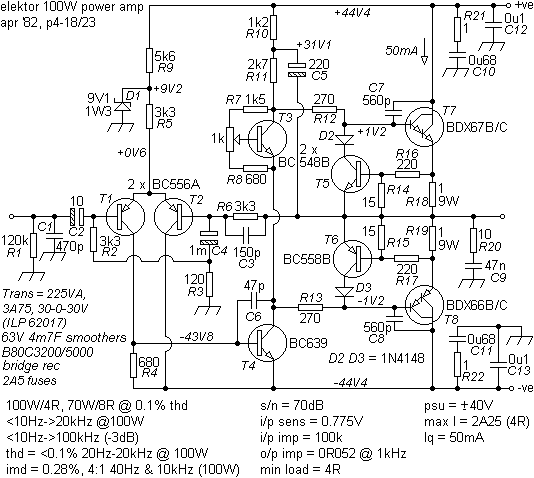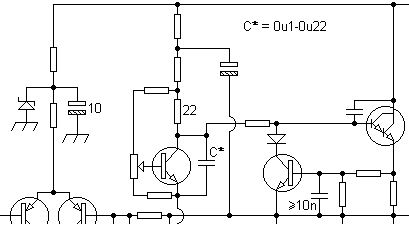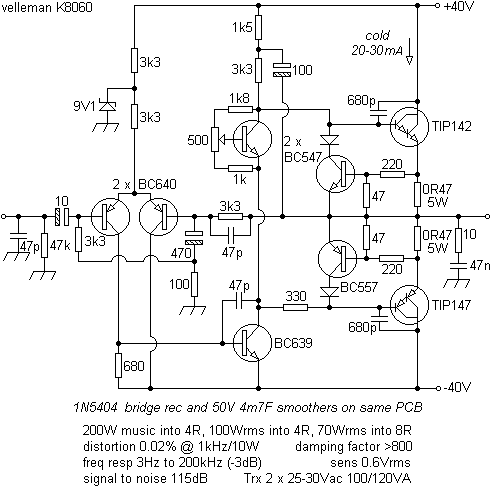Elektor 100W Darlington amplifier
This design was intended for hi-fi use, or as a slave, bridging a gap between lower and higher power offerings, 'the need arose for an inexpensive, good quality, medium rated power amplifier design'. Design criteria were: must deliver 100W into 4 ohms, distortion must not exceed 0.1% at 100W (even at 20kHz), extensive power bandwidth, 'short-circuit proof', symmetrical supply negating use of output coupling capacitors, easy-to-obtain components, straightforward construction and calibration, should be economically viable and reliable.

Relatively unsophisticated, with a low component count, the input was bootstrapped to increase the input impedance and current-limiting was included to supplement the fuses in the supply lines. Notable is the zener stabilised input 'tail', the class A driver being fed by the input transistor directly, the relatively low impedances of feedback network (and high value of DC blocking cap), 'tight' output transistor Vce of 100V, but conservatively rated mains transformer (mains filtering recommended).
The bridge rectifier, smoothers, fuses and indicator LEDs were mounted on a separate PCB that sat below the amplifier PCB of the same size making a compact structure. Each output device had it's own SK84 1.2°C/W or SK03 100mm 1.8°C/W heat-sink. Adding a transformer then offered a complete and compact power amplifier solution.
Although no problems were encountered by the author and other constructors, compared to the later (December) Crescendo FET design which many thought unstable (two later versions of the Crescendo were published in May '84 - the 'Mini' and April '01 - the ME), the following mods were suggested by one builder to overcome the HF problems that he experienced;
"Reduce C6 to 27pf, and C7 and C8 to 10pF. Remove C1 and the current-limiting (T5, T6, D2, D3, R13, R15, R17 and R19). Parallel 0µ1F with D1 and 1µF (non-polarised) across bias transistor (T2, C to E). Replace C2 with 2µ2F (non-polarised) and fit a screen between the stackable PSU and PA PCBs."No thermal feedback for the bias was possible in the original, the bias transistor being mounted on the upper PCB, close to the input pair.
A variety of complementary Darlington pairs have been used in this design (the originals offering 150W, 100V, 3MHz, hFE 1,000). Lower power versions using MJ2501/3001 (150W, 80V, 1MHz, hFE 1,000 @ 5A) output devices have been seen, as have others with higher power stages using faster MJ11015/16s (200W, 120V, 2MHz, hFE 2,000 @ 20A). Versions with Rs 16-19 halved in value have appeared.
Additional components, intended to improve performance have been added to some builds.

A popular and easily upgraded design, sometimes described as 'winning' especially when compared in 'blind' tests with more complex circuits, that bears resemblances to older RCA designs. After more than 25 years versions are still being built, Velleman's (2008) K8060 amplifier (below), K8081 amplifier and K8077 sub-woofer kits all use designs which are a close match, less one resistor. Recommended heat-sink (for both output devices) 1.2°C/W.

Looking at the respective RC networks, the original version offers a gain of 28.5 somewhere between 1.33Hz - 321kHz, whilst the much later Velleman gives a gain of 34 between 3.39Hz - 1.026MHz with half the quiescent current using higher gain (125W, 100V, hFE 3,000 @ 5A) output devices. Personal preference would retain the lower HF roll-over and increase the higher LF roll-off, ie; 10Hz - 300kHz. Additional bi-polar caps across the electrolytics, zener and bias transistor could improve, as can attention to the bias, as seen in the Velleman where the bias transistor is fitted to the heat-sink. Loading the base-emitters of the protection pair with capacitance will prevent triggering on permissible transients. No version seen has a thermally mated input pair.
Has anyone run any of these with FETs?
Another 'good' Elektor design (300W/4R, Nov '95) by A. Riedl, based on an earlier 600W design with five output pairs.
especially if you want additional content to this page
or if you find any links that don't work. Don't forget
to add the page title or URL. Take care!